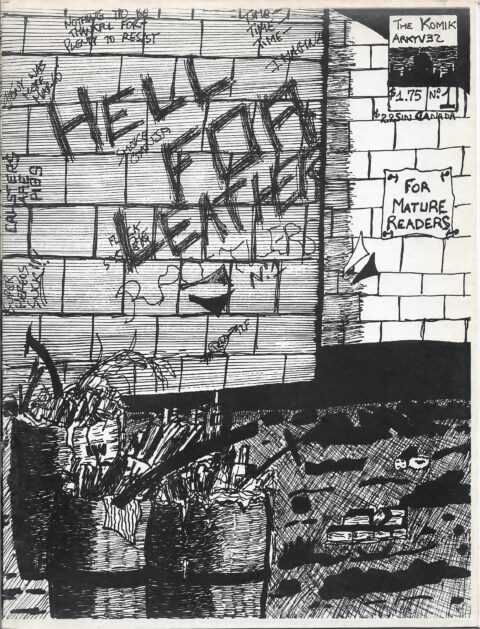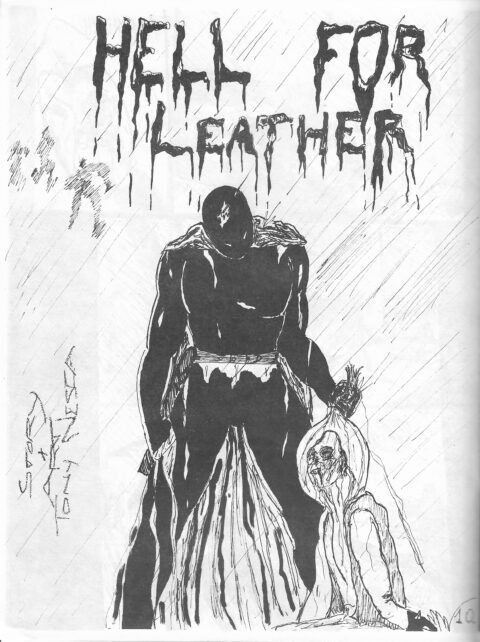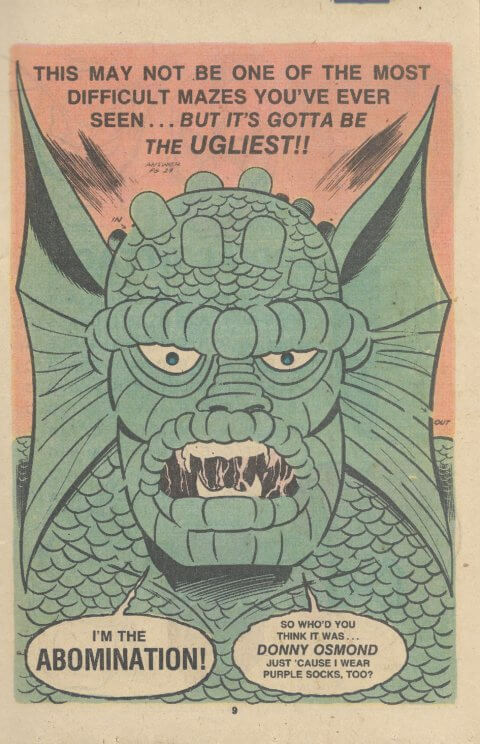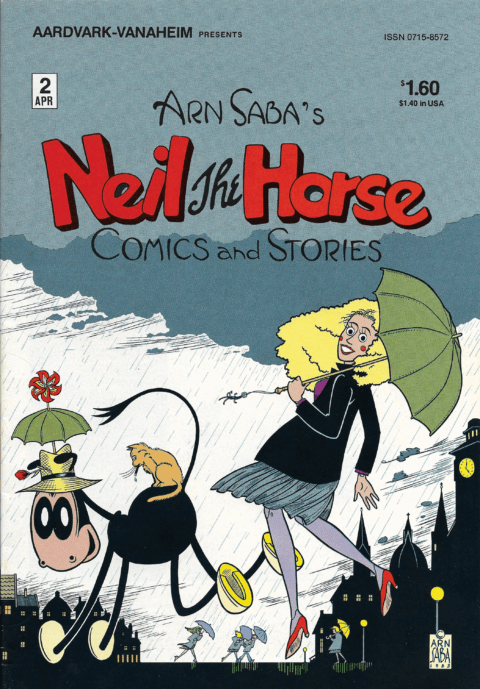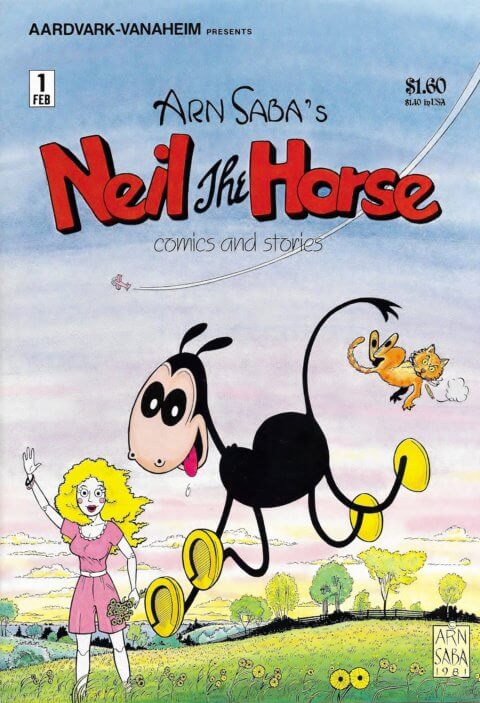Despite last year having many starts and stops, including my personal hiatus (and a wider hiatus by our research group), Dan, Victor and I were able to uncover about a dozen “new” comics from the Canadian Silver Age that we were not already previously aware of. The most recent discovery came last fall and it has been several months since there have been any new leads. Finding these “new” comics is one of the most exciting parts of doing this kind of research.
Hell for Leather # 1 is the most recent comic that I have added to my master list. This magazine size comic was self-published in 1989 in Winnipeg by Tony Nesca under the name “The Komik Arkyves.” Nesca created the comic by himself, writing the story and providing the artwork. As far as I can tell, his foray into comic books begins and ends with Hell for Leather # 1.
Nesca was born in Italy in 1965 and his family moved to Canada when he was three years old. The family moved back and forth between Italy and Winnipeg when Nesca was a child, before finally settling in Manitoba for good. By the time Hell for Leather was created, Nesca was approaching his mid-20s and had been playing guitar as part of a rock band that performed at various Winnipeg bars. His dabbling in comics was the beginning of a transition to becoming a writer, which I will return to at the end of this article.
I first learned about this comic due to it being profiled in a Power Comics YouTube video. I learned of the video a few months after it was released and was able to track down a copy for my files with a bit of effort.
Before delving into the insanity that is Hell for Leather, I want to provide a bit of exposure for Power Comics. The group has been around since 2011 but really ramped up at the beginning of 2021 after being on hiatus for several years. Power Comics is a visual and video exploration of obscure small press comics from the 1980s and 1990s. According to their Patreon, their main objective is to: “identify, and canonize the weirdest and wildest issues from a bygone era showing the world that these once forgotten works and shattered dreams have now perfectly aged into the fine wine of outsider art.” Power comics is curated and presented by Evan Husney (who is best known as the co-creator of the wrestling documentary television series Dark Side of the Ring on Vice), his pal Gabriel Dikel and artist Benjamin Marra. The first iteration of their project appeared on Tumblr (which hasn’t been updated in years and also mentions Zack Carlson as a co-curator, though I am not sure if he is still involved in the project). These men are doing interesting work and I highly recommend checking out what they are up to. They are also quite active on Instagram.
Hell for Leather # 1 is an example of work where the creator bit off more than they could chew. It is an ambitious work that has an interesting narrative but stumbles out the gate because of its poor artwork. The end result is a comic that feels more like a storyboard than a finished product. The comic immediately stands out as being an amateur production because of its scribbly and distracting artwork. Nesca would have benefitted dramatically from hiring a polished artist to bring his vision to life and this comic may have had legs if the artwork was better: this is a tale of a gritty vigilante antihero that makes sense in a comic landscape after the publication of The Dark Knight Returns and in some ways anticipates tropes that would be found a few years later in Spawn. For example, Nesca’s use of television news stations presenting part of the background narrative at different points in the comic is something that Frank Miller employed in The Dark Knight Returns and is something that Todd McFarlane used continuously during early issues of Spawn.
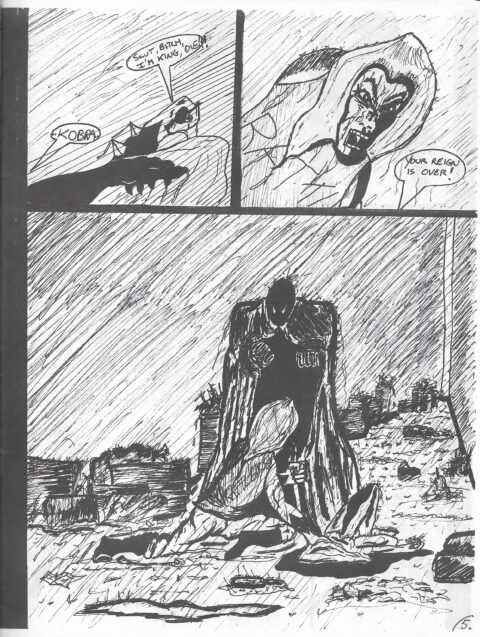
The story takes place in a dystopian alternate version of 1965 where Russia and the West are allied and the world has united after making first contact with a group of aliens called the “Valdorians.” Class conflict and poverty loom large, with gangs, serial killers, and homeless, drug-addicted punks co-existing on the streets. Despite the presence of technologically advanced aliens, not much seems futuristic here, outside of some hovercars and a few other embellishments throughout the comic. In fact, the setting feels more like the Reagan-Mulroney era than the 1960s.
The issue starts with a costumed vigilante hunting a gang leader named “King Kobra” across several pages. King Kobra gets beaten to a pulp, leading to a large police and media presence afterwards. We quickly learn that news reporter, Sandy Vale, is something of a nuisance for the police. Once Vale learns that a costumed vigilante is responsible for King Kobra being left beaten and bloodied, the background story becomes focused on issues about whether the vigilante is a hero (as presented by the media and internalized by the impoverished characters living on the street) or a villain (as presented by the police and worried elites). This part of the narrative feels like an homage to Watchmen and The Dark Knight Returns and again anticipates tropes found a few years later in Spawn.
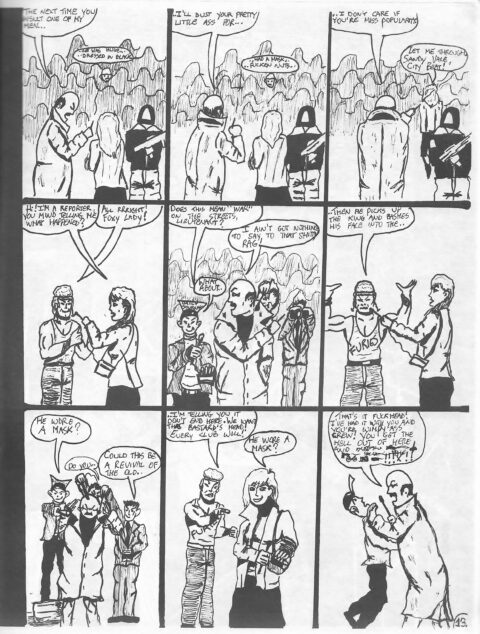
As the comic continues, the costumed vigilante patrols the streets and encounters low-level gang members, as well as a serial killer. However, he soon learns that the victims he saves are just as scared of him as they are of their would-be attackers.
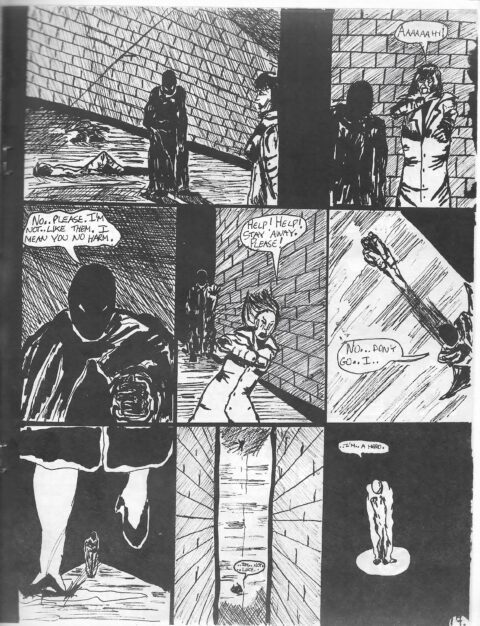
As the story progresses, the costumed vigilante continues to clean up the streets by going after low-level members of King Kobra’s gang, as well as a serial killer. Of course, the police aren’t happy with these developments.
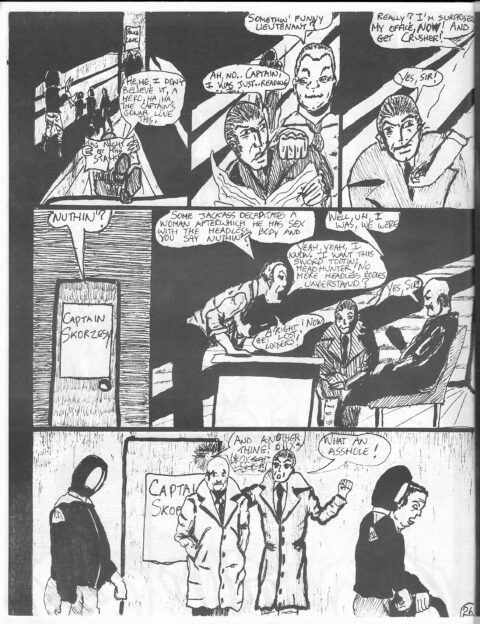
As we approach the end of the narrative, the costumed vigilante comes face to face with remaining members of King Kobra’s gang, “The Rattlers,” while news reporter Sandy Vale discusses whether or not the vigilante is a hero or villain to her television audience. Vale makes it clear that she is a fan of the vigilante cleaning up the streets.
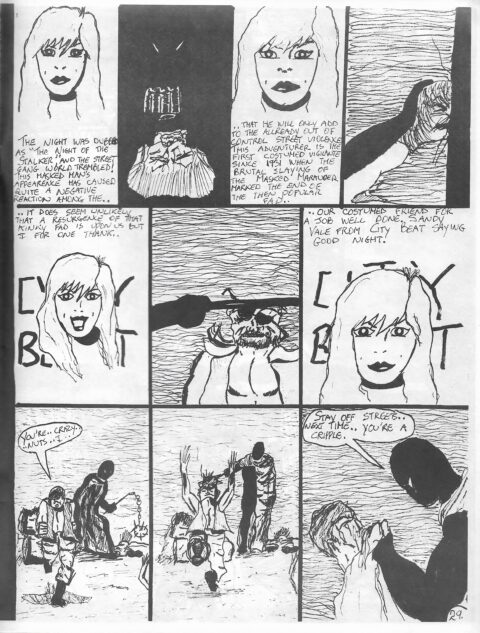
The comic (and series) comes to an end with the street punks opining about the Valdorians and the costumed vigilante. The final frame includes a quote from Dave Faulkner, who was the vocalist for the Australian rock band the Hoodoo Gurus. A bit of quick research reveals that the band released a song in 1987 called “Hell for Leather” on their album Blow Your Cool! This is obviously where Nesca sourced the name for his comic.
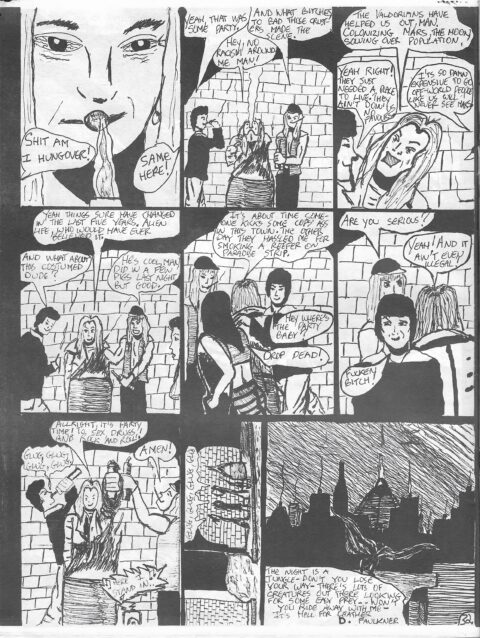
Hell for Leather was envisioned as a continuing series, as explicitly made clear on the inside of the back cover, which mentions that issue # 2 is coming soon. As far as I know, a second issue was never released. Ultimately, the amateur artwork in Hell for Leather is quite distracting and makes reading the comic difficult. This is a shame because, despite ripping off The Dark Knight Returns in certain respects, this comic offers an interesting narrative that could have worked if a capable artist was at the helm.
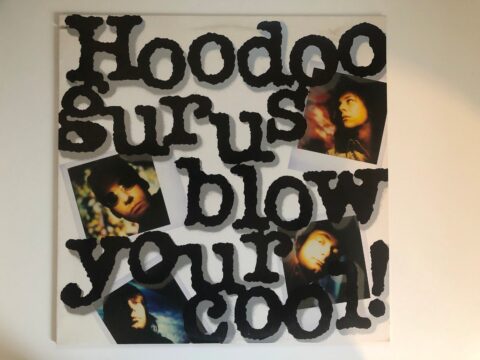
Nesca does show flourishes of being an okay artist, particularly in his single-page drawings, but it is not enough to hold this comic together. Instead, this feels like reading a crude storyboard and ages like outsider art, making this a prime example of a Canadian “Power Comic.” The artistic failures of this Spawn-esque comic could have easily been avoided if Nesca had focused on writing and found someone else to take over the artwork. Despite the artistic limitations in Hell for Leather, I still found it to be an incredible amount of fun and am glad to have copies in my collection.
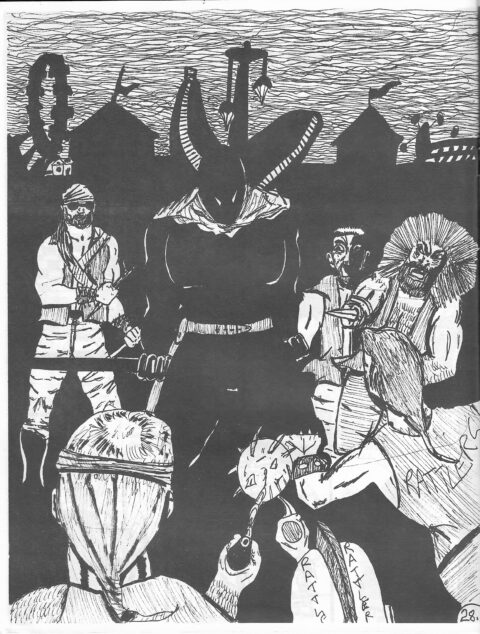
Putting all of this in perspective, this early work by Nesca helped to set the stage for a successful career in Winnipeg’s underground literature scene as a poet and storyteller. Today, he and his wife, Nicole Nesca, are co-owners of Screamin’ Skull Press, where they self-publish their own poetry chapbooks, novels, and collections of short stories.
Full disclosure: I have not read any of their books. However, knowing that today Nesca is a successful writer (and is still based in Winnipeg) makes Hell for Leather more interesting than other amateur comics from the late Canadian Silver Age. There are numerous examples of such comics where the creators disappear from the scene altogether but do not continue to produce meaningful works of art in a separate medium. For Nesca, Hell for Leather is part of a larger trajectory and is something of a stepping stone towards becoming a proper writer and for that reason, it makes it a more compelling work.
To date, the Nescas have published six poetry chapbooks, six collections of short stories and another six novels. Tony Nesca’s seventh novel, Calabritto, is coming out this month. Details are available on the Screamin’ Skull Facebook page.
Whenever we uncover a comic from the Canadian Silver Age that we did not already know about it is incredibly thrilling. We have been at this for half a decade and I have personally catalogued 2159 comics from the era. Finding “new” comics has become less and less frequent over the past couple of years, but I like to imagine that there are still many comics out there that we don’t know about yet.
When something like Hell for Leather comes out of the woodwork, I immediately check to see if the comic was hiding in plain sight and merely slipped under our radars. This has happened a couple of times in the past, where we learn of a “new” comic that everyone else already seemed to know about. On the other hand, most of the “new” comics we have learned about over the past couple of years have lacked an internet footprint. This is true for Hell for Leather # 1. If it hadn’t been for Power Comics covering the comic on YouTube, this comic would still be a mystery to me. When I learned about the comic, I was able to purchase the last two copies available from an eBay dealer based in the USA who had been slowly selling off a dozen or more copies for a number of years. Several months later, I have not found any other copies for sale. I have no idea how many copies Nesca printed. This could be extremely rare, or it could be common. Nevertheless, the only profile of the comic that I can find is the one that Power Comics released last year.
So, which one of you is hoarding all of those copies of Hell for Leather # 1?
Thanks for reading, everyone! See you next month when I profile another obscurity from the Canadian Silver Age.

